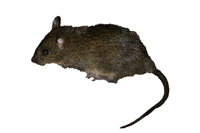Wetlands Wildlife 1: Energy Flow
WETLANDS WILDLIFE1: Energy Flow

Magpie geese, Bamurru, Yellow Waters (Ian Morris)
Food chains and food webs
Food chains and food webs will possibly be familiar to you from your primary school days. They are, however, handy conceptual devices, which demonstrate how a wetland species will rely on the presence and abundance of one species to provide the energy needed for it to sustain life. In presenting or constructing food chains the focus is on the ability of green plants to convert raw materials (carbon dioxide and water) into energy foods which can then be passed along a chain of consumers (herbivores and carnivores). The plants are the producers of an ecosystem and all other life forms, known as consumers, depend on them to initiate the supply of energy throughout the system.
| PRODUCERS |
|
1ST ORDER CONSUMERS |
|
2ND ORDER CONSUMERS |
|
plants |
herbivores | carnivores | ||
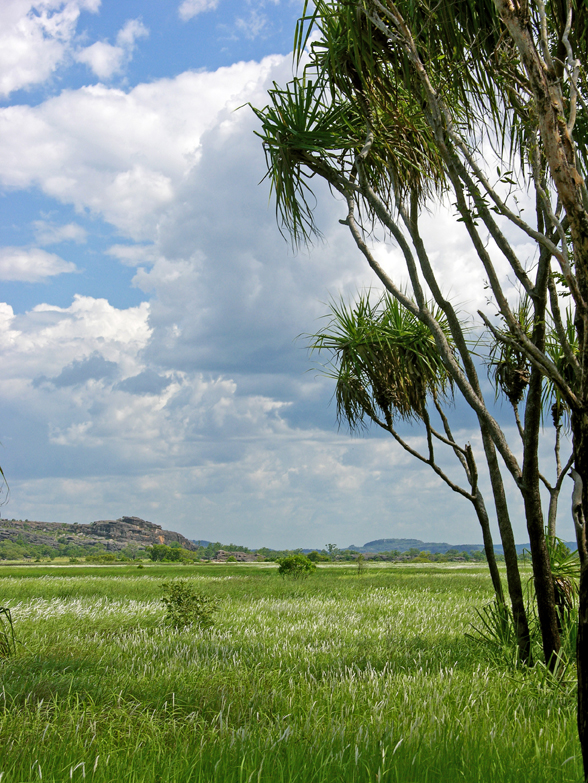 |
 |
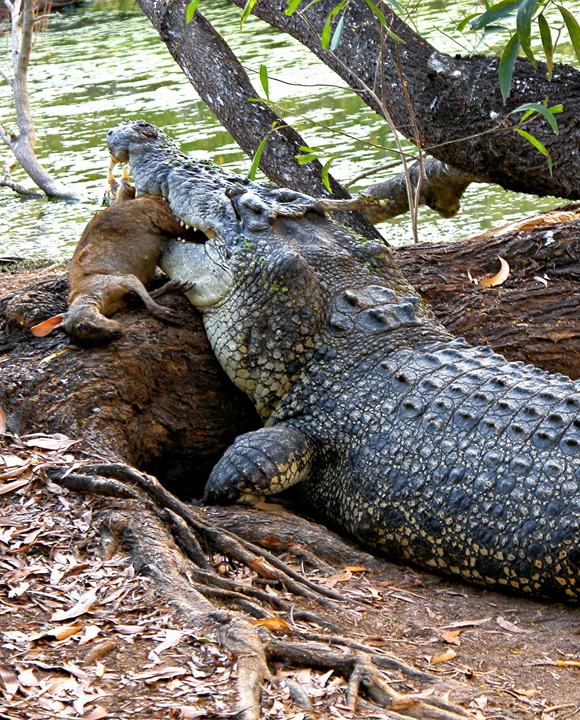 |
||
|
Figure 1. Outline of a basic Food Chain |
||||
A common food chain of the Top End wetlands shows that producers are the basis of all food chains:
|
|||||||||||||||
| Figure 2. Common Food Chain of the Top End |
The Dusky Rats (Rattus colletti) live in cracks and burrows on the grassy floodplains and, under good conditions, breed quickly. Their numbers build up in the early months of the dry season when sedge plants are still easily found. The Water Pythons (Liasis fuscus (Bothrochilus)) enter the burrows and feed on the Dusky Rats, needing no other prey with such an abundance of food. Ecologists estimate that if all the Pythons and Dusky Rats living in one square kilometre of floodplains were weighed at the most favourable time of the year, they would weigh more than all the large animals (rhinos, elephants, giraffes) that live on one square kilometre of African savanna, such is the abundance of their numbers.
Towards the end of the dry season, there are very few corms (tubers) left in the hard soil and the numbers of Dusky Rats decline. When the wet season arrives, the Rats abandon their burrows and migrate towards the higher ground of the fringing woodlands. The Water Pythons follow them, but their declining numbers force the water Pythons to look for other food sources, although they are capable of surviving several months without eating when food is really short. At this time some food chains might be:
| Algae |
 |
Water Snail () |
 |
Comb-crested Jacana |
 |
Water Python |
 |
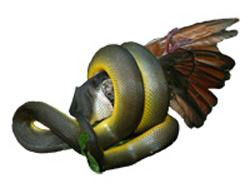 |
|||||
| Grass |
 |
Agile Wallaby |
 |
Water Python (Liasis fuscus (Bothrochilus)) |
||
 |
 |
|||||
| Dead Leaves |
 |
Native Cockroach |
 |
Northern Brown Bandicoot |
 |
Water Python |
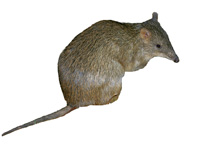 |
 |
|||||
| Figure 3. Different Food Chains of the Top End Wetlands | ||||||
It is a convention that the arrows leading from one animal to another always point from prey to predator. It represents the flow of energy (i.e. as food) from one organism to the next in the food chain. The pathway indicated by the arrows is sometimes called an energy flow path.
In all food chains decomposers are the final element for they are the last organisms to make use of the original energy input. After invertebrates have broken down the main components of a dead animal, it remains for the bacteria to bring about the final stages of decomposition in which nutrients are returned to the soil (or water). The energy originally produced by the plants in the food chain is dispersed along the way as heat loss, and energy used to sustain life.
The three examples shown demonstrate that the same species can occur in a number of chains, and so a food web can be constructed showing the energy flow - or predator-prey relationships - between a number of animals. To the above food chains we can add the Olive Python (Liasis olivaceus (Bothrochilus)) and the Letter-winged Kite (Elanus scriptus), both also predators of the Dusky Rat, and combine them to create a food web (Figure 4). The Olive Python is usually found near tree-lined billabongs and it also eats lizards and birds.

Figure 4. A Wetland Food Web
As well as preying on the Dusky Rat of the Top End wetlands, the Letter-winged Kite is the main predator of the Long Haired Rat (Rattus villosissimus) that reaches plague proportions in the Barkly Tableland and the Channel Country.
It is important to realise that nature is more complex than the food chains and food webs suggest. A habitat is always changing due to seasonal variations in rainfall and prevailing winds. These changes can affect food sources at any given time.
Other factors such as available shelter enter into the picture. Goannas may like to eat young Galahs (Cacatua roseicapilla), but there needs to be a sufficient number of dead branches in a habitat for Galahs to commence breeding before the goannas can make use of that particular food resource. Shelter can also be related to landforms, such as caves for bats, rocky hills for Commons Wallaroos, or Euros (Macropus robustus).
Some animals may belong to two or more habitats, for example migrating birds, and will be part of different food webs in each. Some animals are cannibals and eat the young of their own species. Obtaining food may simply be a matter of size: the larger northern Giant Frog (Cyclorana australis) will catch and attempt to eat smaller frogs such as Green Tree Frogs (Litoria caerulea). External and internal parasites also play a significant part in food webs.
In constructing a food web, consider the life cycles of the animals involved. Juvenile forms will have a different range of food sources and predators than adult forms.
Food pyramids
A food pyramid shows that there are large numbers of producers and progressively fewer numbers of consumers along any food chain in an ecosystem. Each level in a food pyramid is known as a trophic level.
The pyramid can be also based on total mass needed to support one top predator for a given period of time, or it can be expressed in terms of the percentage of energy lost (through heat, growth, etc) along the chain. However the idea is the same. Not only are green plants the driving force behind the production of energy and uptake of nutrients in an ecosystem, but they, or other producers, need to be the most abundant life form present in a system.
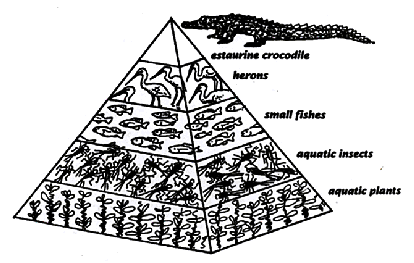
Figure 5. A wetlands food pyramid.
There are a number of ecological principles that are linked to the food pyramid concept. Predators at the top of the pyramid, at the highest trophic level, are most at risk from toxic chemicals introduced into an ecosystem. Any harmful substances introduced to the wetlands (pesticides, herbicides, and heavy metals) are spread across a large number of animals at the lower levels, but they become more concentrated at the higher trophic levels. This is called biomagnification. An example of this was the effect of DDT on the egg shells of birds.
Because there needs to be a constant supply of smaller animals as prey, carnivores need to range over large areas and so they are not as numerous as other animals further down the chain. This makes them more susceptible than herbivores to extinction by hunting or loss of habitat.
| 2. Plants of the wetlands | 3. Animals of the wetlands | 4. Biological diversity | 5. Activities |


